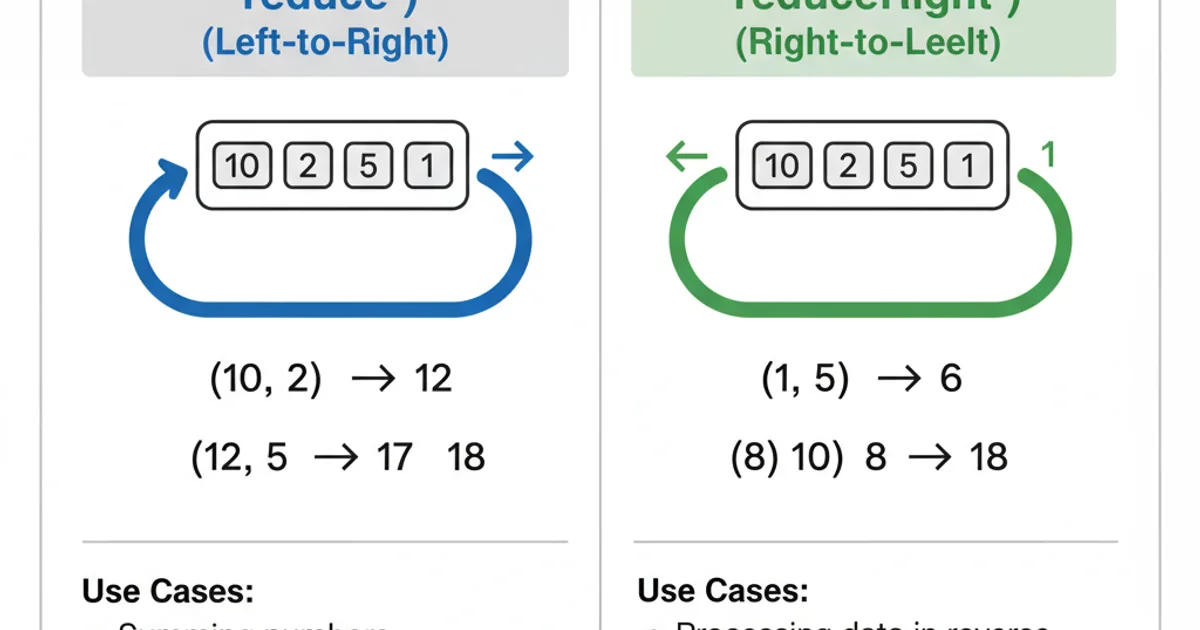when to use reduce and reduceRight?
Categories:
JavaScript's reduce() vs. reduceRight(): Choosing the Right Iteration Direction

Explore the differences between JavaScript's reduce() and reduceRight() methods, understand their use cases, and learn when to apply each for effective array manipulation.
JavaScript's Array.prototype.reduce() and Array.prototype.reduceRight() are powerful methods for iterating over an array and accumulating a single result. While both serve the purpose of reducing an array to a single value, their fundamental difference lies in the direction of iteration. Understanding this distinction is crucial for writing efficient, predictable, and bug-free code, especially when the order of operations matters.
Understanding reduce(): Left-to-Right Accumulation
The reduce() method executes a user-supplied 'reducer' callback function on each element of the array, in ascending index order, passing in the return value from the calculation on the preceding element. The final result of running the reducer across all elements of the array is a single value. It's commonly used for tasks like summing numbers, flattening arrays, or counting occurrences.
const numbers = [1, 2, 3, 4, 5];
// Summing all elements
const sum = numbers.reduce((accumulator, currentValue) => accumulator + currentValue, 0);
console.log(sum); // Output: 15
// Flattening an array of arrays
const arrayOfArrays = [[1, 2], [3, 4], [5, 6]];
const flattened = arrayOfArrays.reduce((acc, val) => acc.concat(val), []);
console.log(flattened); // Output: [1, 2, 3, 4, 5, 6]
Basic usage of reduce() for summing and flattening.
initialValue to reduce(). If not provided, reduce() will use the first element of the array as the initial accumulator value and start iteration from the second element. This can lead to unexpected behavior or errors with empty arrays.flowchart LR
A[Start] --> B{Array: [1, 2, 3, 4]}
B --> C["Initial Value: 0"]
C --> D["Iteration 1: acc=0, curr=1 -> 1"]
D --> E["Iteration 2: acc=1, curr=2 -> 3"]
E --> F["Iteration 3: acc=3, curr=3 -> 6"]
F --> G["Iteration 4: acc=6, curr=4 -> 10"]
G --> H[Result: 10]Visualizing reduce() iteration from left to right.
Understanding reduceRight(): Right-to-Left Accumulation
In contrast, reduceRight() works almost identically to reduce(), but it processes the array elements in descending index order (from right to left). This can be particularly useful in scenarios where the order of operations from the end of the array is significant, such as processing a stack, undoing operations, or constructing a string in reverse.
const words = ['world', 'hello'];
// Concatenating words in reverse order to form a sentence
const sentence = words.reduceRight((acc, word) => acc + ' ' + word);
console.log(sentence); // Output: "hello world"
const operations = ['add 5', 'multiply by 2', 'subtract 3'];
// Simulating undo operations (order matters)
const undoLog = operations.reduceRight((log, op) => log + `Undo: ${op}. ` , '');
console.log(undoLog); // Output: "Undo: subtract 3. Undo: multiply by 2. Undo: add 5. "
Examples of reduceRight() for reverse concatenation and undo logging.
initialValue with reduceRight() as well. If omitted, the last element of the array becomes the initial accumulator, and iteration starts from the second-to-last element. This can be a common source of errors if not handled carefully.flowchart LR
A[Start] --> B{Array: [1, 2, 3, 4]}
B --> C["Initial Value: 0"]
C --> D["Iteration 1: acc=0, curr=4 -> 4"]
D --> E["Iteration 2: acc=4, curr=3 -> 7"]
E --> F["Iteration 3: acc=7, curr=2 -> 9"]
F --> G["Iteration 4: acc=9, curr=1 -> 10"]
G --> H[Result: 10]Visualizing reduceRight() iteration from right to left.
When to Choose Which?
The choice between reduce() and reduceRight() primarily depends on the nature of your accumulation and whether the order of processing elements affects the final outcome. For most standard aggregations (sum, average, flattening), reduce() is the default and often more intuitive choice. However, reduceRight() shines in specific scenarios where reverse order processing is logically required.

Key differences and use cases for reduce() vs. reduceRight().
Consider the following guidelines:
reduce()(Left-to-Right):- Default choice for most aggregation tasks (sum, product, average).
- Flattening arrays.
- Counting occurrences of items.
- Transforming an array into an object or map where order doesn't inherently reverse the logic.
reduceRight()(Right-to-Left):- Processing a stack-like data structure where the last item added is the first to be processed.
- Reversing a string or array (though
reverse()is often more direct for arrays). - Building a sequence of operations where the 'undo' or 'reverse' logic is applied from the end.
- When dealing with operations that are not associative or commutative, and the right-to-left order yields the desired result.
reduce() and reduceRight() will yield the same result. However, for non-associative operations (e.g., string concatenation where order matters for the final string) or operations where the context of the previous element is crucial, the direction becomes critical.